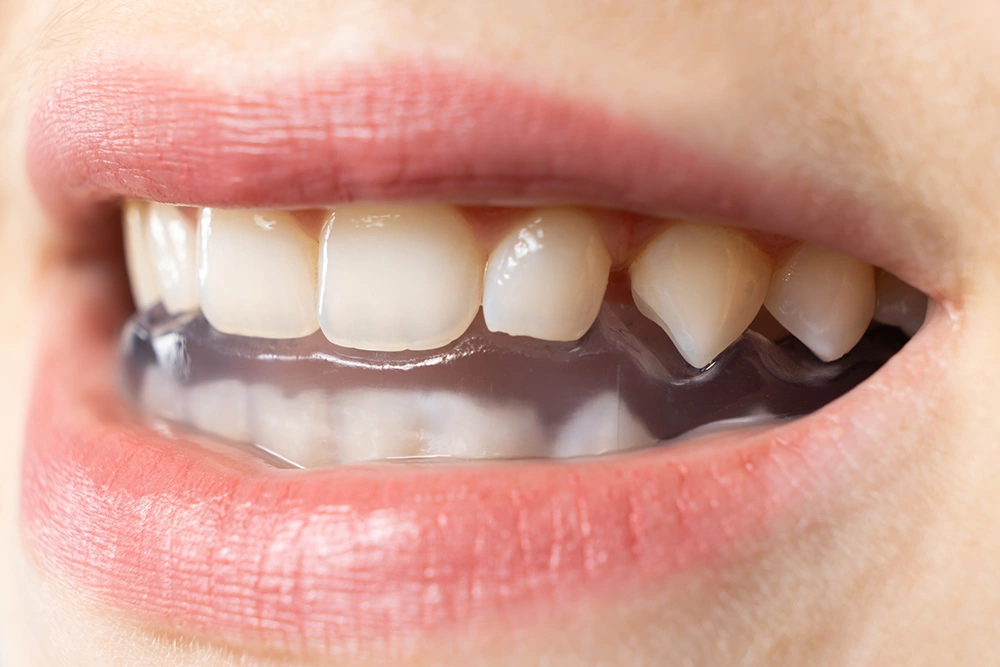Sleep Disorders Treatment
Before any dental intervention, we strongly advocate for a comprehensive sleep diagnosis to uncover any underlying sleep disorders linked to dental issues. At our clinics in Miami, Fort Lauderdale, FL, we focus on treating dental problems that contribute to sleep disturbances, utilizing specialized ProSomnus devices designed for this purpose.
-
Addressing Dental Issues to Improve Sleep. Dental problems can lead to or exacerbate sleep disorders, affecting overall health and well-being.
-
A detailed bite examination is crucial, particularly for individuals who have had braces, to identify any dental irregularities contributing to sleep issues.
-
ProSomnus Sleep Devices. These devices offer a comfortable and effective solution without the need for masks, hoses, or surgery, leading to improved sleep quality for our patients.
We use ProSomnus for sleep disorders
ProSomnus is a brand of precision, custom-made oral appliances designed to treat obstructive sleep apnea (OSA) and snoring. Unlike traditional Continuous Positive Airway Pressure (CPAP) machines, ProSomnus devices are non-invasive, fitting inside the mouth to adjust the position of the jaw and tongue during sleep.
1
Diagnosis and Prescription: The journey begins with a diagnosis of OSA or snoring by a healthcare professional. If ProSomnus is deemed a suitable treatment, a prescription is provided.
2
Customization: Impressions or digital scans of the patient's teeth are taken to design a device that fits perfectly. This customization is crucial for comfort and effectiveness, ensuring the device precisely aligns with the individual's dental anatomy.
3
Fitting and Adjustment: Once the ProSomnus device is manufactured, the patient receives a fitting session where the device is adjusted to the correct position to optimize airway openness without compromising comfort.
4
Usage: The patient wears the device during sleep. Its design gently repositions the lower jaw and tongue forward, preventing airway blockage. This repositioning is key to reducing or eliminating the symptoms of OSA and snoring.
5
Follow-up: Regular follow-ups with the healthcare provider are essential to monitor the treatment's effectiveness and make any necessary adjustments to the device.
What are sleep disorders?
Sleep disorders are diseases that disrupt normal sleep patterns, affecting a person's ability to recover. These disorders include insomnia, sleep apnea, restless legs syndrome, narcolepsy, and others.
There is a direct connection between sleep disorders and dental health. For example, sleep apnea often comes with snoring and mouth breathing, leading to dry mouth, gingivitis, and periodontitis.
Nighttime bruxism (teeth grinding) leads to enamel damage – causing teeth to misalign and making it harder to chew. Also, enamel can develop micro-damages (cracks, chips) where pathogenic bacteria accumulate, increasing the risk of developing cavities.
Sleep disorders also lead to excessive daytime sleepiness. This can worsen dental hygiene quality, and inflammations and infections can develop more actively.
Symptoms of Sleep Disorder

Patients with sleep disorders often complain of:
-
Excessive daytime sleepiness
People may struggle to stay awake during the day, feel excessively tired despite sufficient sleep duration, and have difficulty concentrating on tasks.
-
Snoring
It may be accompanied by gasping or choking sounds, indicating breathing disruptions during sleep – often a symptom of sleep apnea.
-
Breathing disruptions
Partners or family members may observe episodes of breathing cessation during sleep, followed by sharp awakenings or gasping, indicating sleep apnea.
-
Morning headaches
Waking up with a headache can be a symptom of obstructive sleep apnea or bruxism. Morning headaches may result from reduced oxygen concentration or muscle tension related to sleep disruptions.
-
Fragmented sleep
This is an interruption of the sleep cycle, leading to frequent awakenings during the night. It may arise from sleep apnea, restless legs syndrome, or periodic limb movement disorder.
-
Difficulty falling asleep
Hard to fall asleep despite feeling tired. Also, the patient may wake up during the night and have difficulty returning to sleep.
-
Irritability
Chronic sleep disruptions can lead to constant fatigue, irritability, and mood swings during waking hours. Irritability affects interpersonal relationships and reduces overall quality of life.
-
Teeth grinding (bruxism)
Grinding or clenching teeth during sleep can manifest as jaw pain, tooth sensitivity, or accelerated enamel wear. The patient may not be aware of their bruxism until symptoms appear.
-
Periodic limb movements
People may notice repetitive movements of legs, arms, which disrupt their sleep.
-
Memory and concentration difficulties
Chronic sleep deprivation or fragmented sleep can negatively affect cognitive abilities and impact work, study, or daily activities.
Diagnosing Sleep Apnea

The dentist conducts a comprehensive diagnosis in order to identify a sleep disorder.
Uses the Mallampati classification. This method assesses the anatomical features of the upper airways in patients suspected of having breathing disruptions during sleep. The dentist assigns a score based on the visibility of certain structures in the mouth when the patient is sitting, the mouth is wide open, and the tongue is protruded:
-
Class I
Soft palate, uvula, palatine arches, and tonsils are visible
-
Class II
Soft palate, uvula, and palatine arches are visible
-
Class III
Soft palate and the base of the uvula are visible
-
Class IV
Only the hard palate is visible
Based on this classification, the doctor determines the presence and severity of sleep disorders.
During the examination, the doctor may notice that the enamel is worn or severely damaged. These symptoms indicate that the patient suffers from bruxism.
To assess the severity and cause of this problem, the dentist conducts a computer tomography. It allows the doctor to evaluate the condition of the TMJ (temporomandibular joint).
Bruxism & Sleep Disorders
Bruxism leads to severe enamel damage, chips on teeth, and the development of cavities.
The main danger is that the patient may not even know that they grind their teeth in their sleep. This leads to pain: in the jaw, neck, head, ear.
Treatment of bruxism in dentistry consists of two parts:
-
A cap to protect the enamel
The doctor takes an impression of the teeth, based on which a dental overlay is made. It should be worn only at night to protect the enamel from excessive load and damage.
-
Eliminating the cause of bruxism
During diagnosis, the doctor evaluates the function of the temporomandibular joint. If bruxism is due to problems with the TMJ, its treatment is carried out. The dentist also advises undergoing a sleep specialist diagnosis (polysomnography). Based on the results of this study, the doctor will be able to build a complete treatment plan.

How Can You Improve Sleep?
Here are some things you can do if you want to increase the quality of your sleep:
1
Maintain a Consistent Schedule
- Adhering to a consistent sleep and wake schedule, even on weekends. This will help regulate your body's internal clock and improve sleep quality.
- Perform the same activities in the same order before bed. These actions signal your body to transition from wakefulness to sleep. Consider calming activities such as reading, taking a warm bath, or listening to soothing music.
- Minimize daytime naps, especially late in the day or evening, to avoid disrupting your natural sleep-wake cycle.
2
Create a Sleep-Inducing Environment
- Ensure your bedroom has a comfortable temperature (15-19°C) and is dark and quiet. Use blackout curtains, white noise machines, or earplugs to minimize disturbances that could interrupt sleep.
- Limit consumption of caffeine, nicotine, and alcohol before bedtime. Also, avoid using your phone, tablet, and other electronic devices an hour before sleep. These emit blue light, which inhibits the production of melatonin (the sleep hormone).
3
Regular Physical Exercise
- Engaging in regular physical activity strengthens overall health and improves sleep quality. This could include brisk walking or swimming. Aim for at least 30 minutes of exercise on several days a week. Exercise earlier in the day to avoid its stimulating effects close to bedtime.
- Gentle stretching before bed can help relax muscles.
- For individuals with obstructive sleep apnea, weight loss can significantly improve symptoms by reducing excess soft tissue around the airways.
Reviews
FAQ
If a dentist suspects a deep sleep disorder, they refer the patient to a sleep specialist. The specialist conducts a thorough diagnosis and prescribes behavioral therapy, medication, or other treatment methods.


